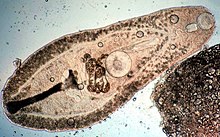| Digenea | |
|---|---|

| |
| Helicometra sp. (Plagiorchiida: Opecoelidae) from the intestine of a Flame Cardinal fish | |
| Scientific classification | |
| Domain: | Eukaryota |
| Kingdom: | Animalia |
| Phylum: | Platyhelminthes |
| Subphylum: | Rhabditophora |
| Superclass: | Neodermata |
| Class: | Trematoda |
| Subclass: | Digenea Carus, 1863 |
| Families | |
Digenea (Gr. Dis – double, Genos – race) is a class of trematodes in the Platyhelminthes phylum, consisting of parasitic flatworms (known as flukes) with a syncytial tegument and, usually, two suckers, one ventral and one oral. Adults commonly live within the digestive tract, but occur throughout the organ systems of all classes of vertebrates. Once thought to be related to the Monogenea, it is now recognised that they are closest to the Aspidogastrea and that the Monogenea are more closely allied with the Cestoda. Around 6,000 species have been described to date.